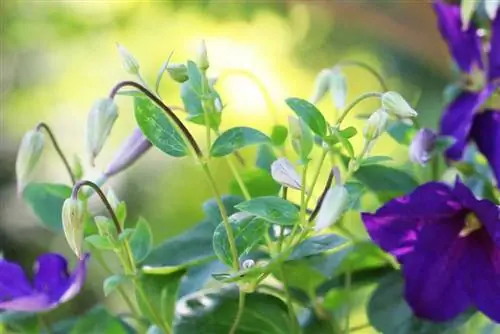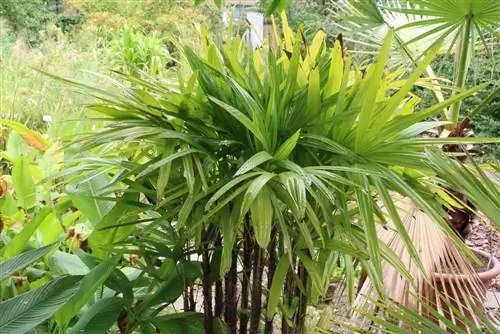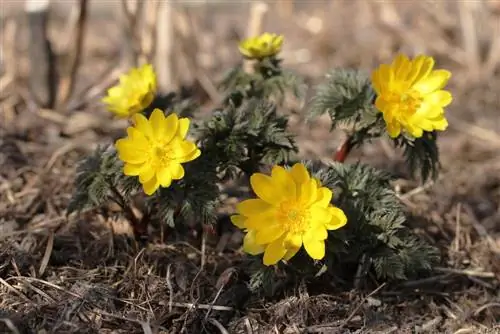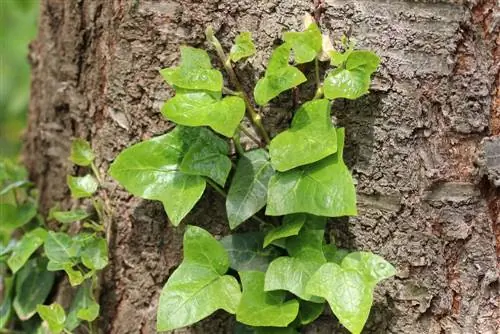- Author admin [email protected].
- Public 2023-12-17 03:39.
- Last modified 2025-01-24 12:45.
Evergreen climbing plants can beautify many areas in the garden. These plants do not form trunks and cannot support themselves. That's why the right location and a supportive climbing aid are extremely important, for example on walls or a climbing frame. The climbing plants can grow up on these and often form immense carpets of leaves. In the local latitudes, sufficient winter hardiness must be ensured.
Ivy
Ivy is a particularly hardy climbing plant that can withstand the extremely cold temperatures of winter. The plant native to this country has the botanical name Hedera helix and has only low demands on the climate and sunlight. Due to its high growth vigor, ivy is suitable as a reliable privacy screen all year round. There are various variants to choose from, which differ in the leaf colors. The adaptable climbing plant grows on almost all types of soil and has robust properties. Ivy is ideal for adding greenery to dead trees, facades, fences, railings, walls and pergolas. Just a single plant can cover an area of up to 500 m² alone. If the ivy gets too big, it can even cause damage to the masonry. Removing unwanted plant parts is often difficult because the roots get stuck to the substrate.
- A north to west facing location is ideal
- Strong growth, annual growth is approx. 2 m
- Can reach heights and lengths of up to 25 m
- But only forms weak adhesive roots
- Relies on support from trellises
- Foliage is dark green and star-shaped
- Inconspicuous, yellowish green flower umbels
- Flowering period from September to October
- Forms pea-sized and black berries, these are poisonous
- Prefers loose, humus-rich and slightly moist plant substrate
- Don't like compacted soils
- Calcareous substrates are optimal
- Does not tolerate acidic pH value
Evergreen clematis
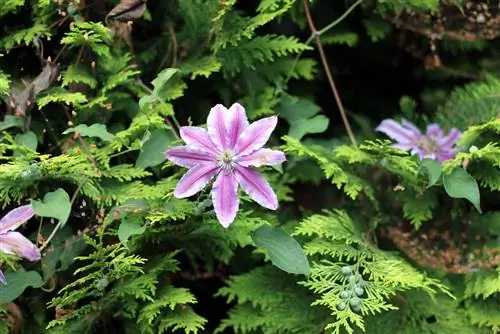
Within the clematis family there are countless varieties, some of which are evergreen. These include specimens of Clematis armandii, which retain their leaves all winter long. These look similar to the leaves of rhododendrons and are an ornament for fences and facades. Unlike ivy, the lush blooms of clematis on the dark foliage are a real eye-catcher. The clematis is sensitive and therefore enjoys a protected location. In order to protect the root ball from dryness and excessive sunlight, a weak underplanting that does not compete with the clematis is recommended. If the clematis is cultivated as a container plant, the pot should be insulated in winter to protect it from excessively hard frost. But even at exposed altitudes, the clematis in the garden enjoys additional winter protection.
- Woody creeper with manageable growth
- Climbs up to 3 m high
- Requires supportive trellis or climbing aid
- Ideal for east and west sides of buildings and facades
- Thrives in bright to partially shaded locations
- Does not tolerate permanent solar radiation
- Good as a container plant
- Leaves are elongated and thick-fleshed
- Produces fragrant white or pink flowers
- Blooms at the end of winter, from March
- It is essential to prevent waterlogging
- Prefers loose and humus-rich soils
- Does not tolerate extremely severe frost
- Cover the ground with brushwood or pine branches as protection
Evergreen Honeysuckle
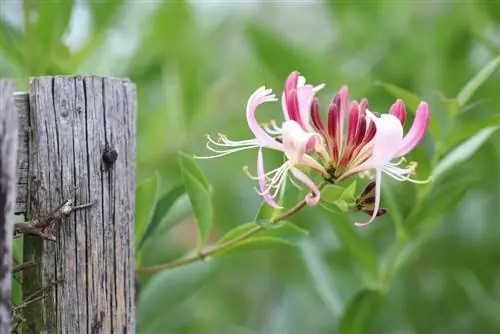
The evergreen honeysuckle has the botanical name Lonicera henryi and is ideal for greening walls, fences and pergolas. However, after a while the creeper also covers unsightly wall crowns and pillars with its winding shoots. However, evergreen honeysuckle is not quite as vigorous as ivy. If a dense and beautifully closed wall of leaves is desired, then climbing aids are necessary. These prevent larger specimens from slipping. Freshly planted honeysuckles enjoy additional winter protection in the first year, especially at exposed altitudes. If the location is too shady, Lonicera henryi will shed from below. If the sun is too strong in winter, you risk unsightly burns. Since the plant is often infested with lice, this should be checked regularly.
- A slightly sunny to partially shaded location is ideal
- Large leaves are lanceolate and fresh green
- Produces yellow-red, rather inconspicuous flowers from June to August
- Small and round berries appear, with a blue-black color
- Reaches heights of up to 8 m and widths of up to 4.50 m
- Medium vigorous, grows between 30-60 cm per year
- Use vertical compartments or net-shaped trellises
- Supporting cross elements and branches are crucial
- The distance to other plants should be at least 2 m
- Prefers nutrient-rich, fresh to moist plant substrate
- Calcareous soils are optimal
- Shade the base of the trunk to protect against dryness
Evergreen creeping spindle
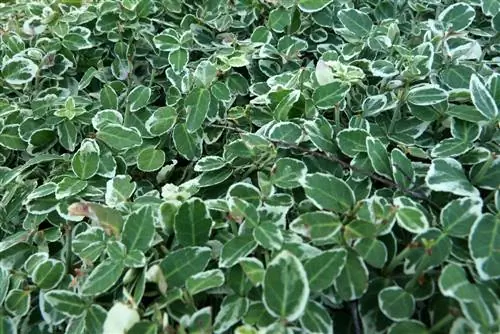
The evergreen creeping spindle has the botanical name Euonymus fortunei and is a rather weak-growing creeper. This is why it is well suited for greening unsightly wall bases and low walls that need to be hidden. But other, unsightly areas in the garden can also be hidden behind it. If contact with the ground occurs, new roots immediately form at this point. For this reason, the evergreen creeping spindle is also very suitable for securing slopes. Thanks to strong adhesive roots, the plant can easily climb walls, although this takes time. The leaves of the climbing plant have a strong luminosity and make for an attractive eye-catcher. Euonymus fortunei has robust properties and is almost as hardy as ivy. However, in the pot, the climbing plant can only tolerate temperatures of up to -5° C in winter.
- Grows as a ground cover and climbing plant
- Tolerates both partially shaded and sunnier locations
- Thrives on all soil qualities
- Leaves are light to dark green and grow close together
- In autumn the color changes, the leaves become redder
- Depending on the variety, the foliage even turns purple in winter
- Becomes about 40-60 cm high and usually twice as wide
- Does not grow strongly or very quickly
- Height growth is approx. 20 cm per year
- Forms a dense carpet of leaves over time
- Inconspicuous flowers only ripen on older specimens
- Flowering time is from May to July
- After flowering, small reddish fruits ripen
- It is possible to keep it as a potted plant
- But needs additional protection in winter
- Pack tubs well when temperatures are below zero in the winter months
True blackberry
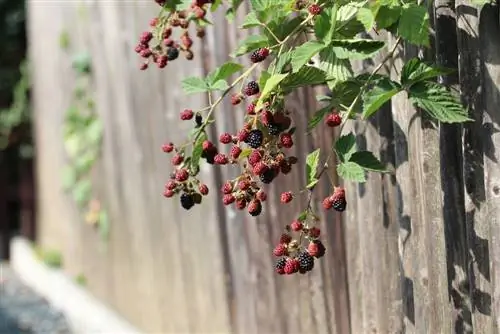
The real blackberry has the botanical name Rubus sectio Rubus and is well suited to local temperatures because of its wintergreen leaves. The native climbing plant has lush growth and soon produces delicious berries. Due to the many thorns, it is ideal for fencing gardens to prevent unwanted entry. With the help of trellises, the blackberry can be cultivated on walls as an espalier fruit. Then the fruits are much easier to harvest and the plant also serves as decorative wall covering. For better fruit development, warm, humid conditions are optimal; the location should be protected from wind and weather. The blackberry vegetation can quickly grow out of control and therefore become a nuisance. The thorny climbing bush often spreads to unwanted places in the garden and is difficult to remove.
- Multi-branched and spiny climbing shrub
- Can cope with full sun to partially shaded locations
- Locations protected from the wind are ideal
- Works well as espalier fruit
- Grows in almost all soil qualities
- But does not tolerate soils that are too dry or too barren
- Reaches growth heights of 0.5-3 m, individual specimens up to 4 m high
- Pinnate leaves are dark green on top and much lighter underneath
- Leaves are not shed in autumn, but remain until spring
- Produces white flowers in June to August
- Blue-black fruits ripen from July to September
- Support growth with wire frames or climbing aids
- When pruning there is a risk of injury from sharp thorns



